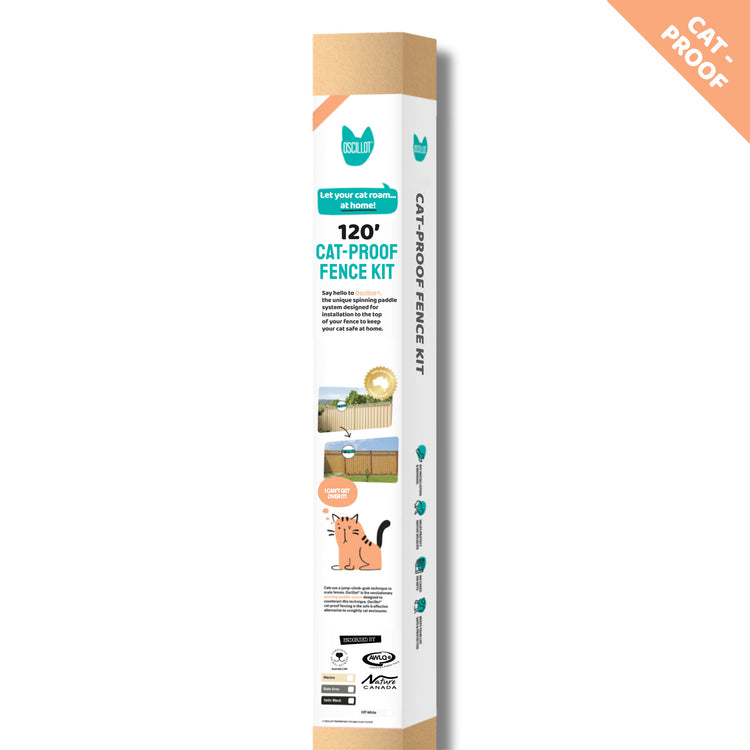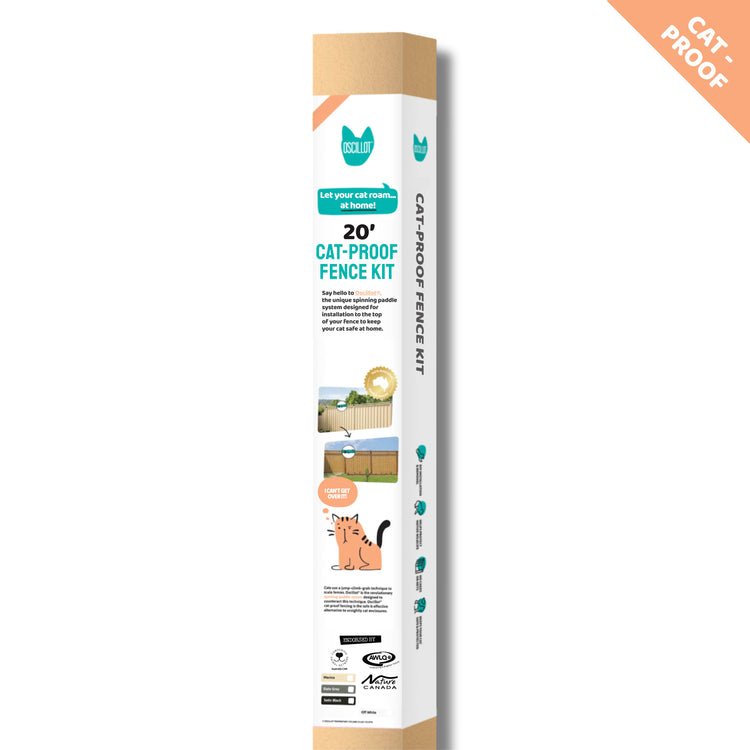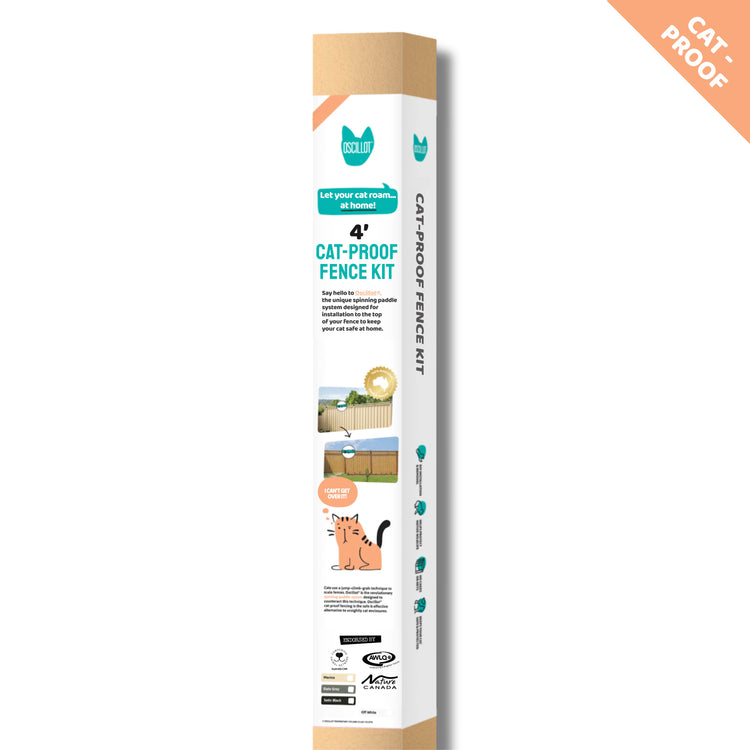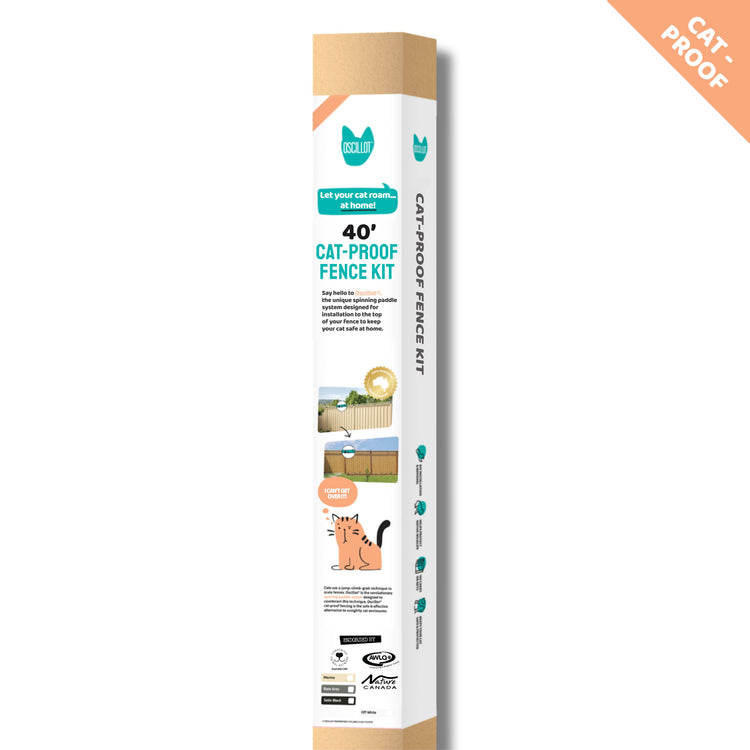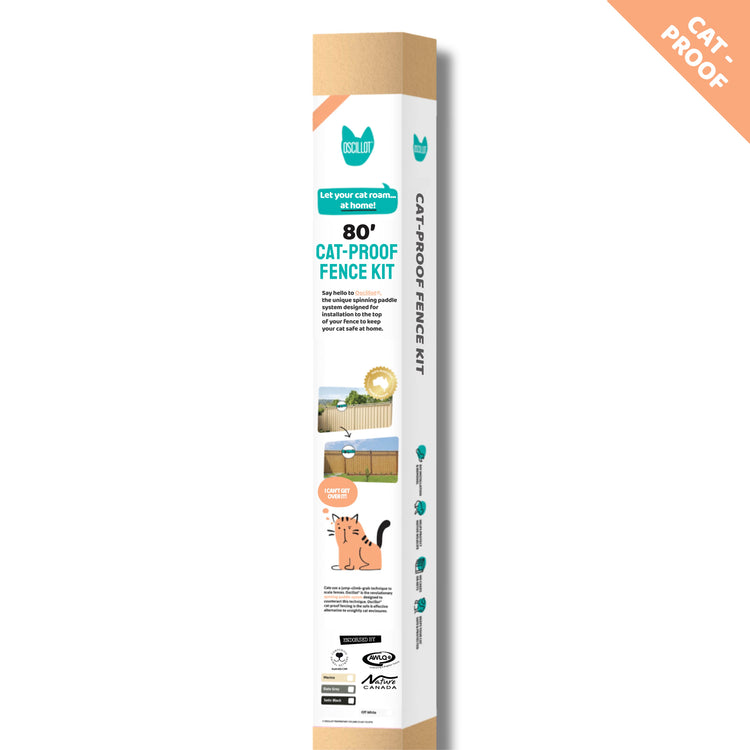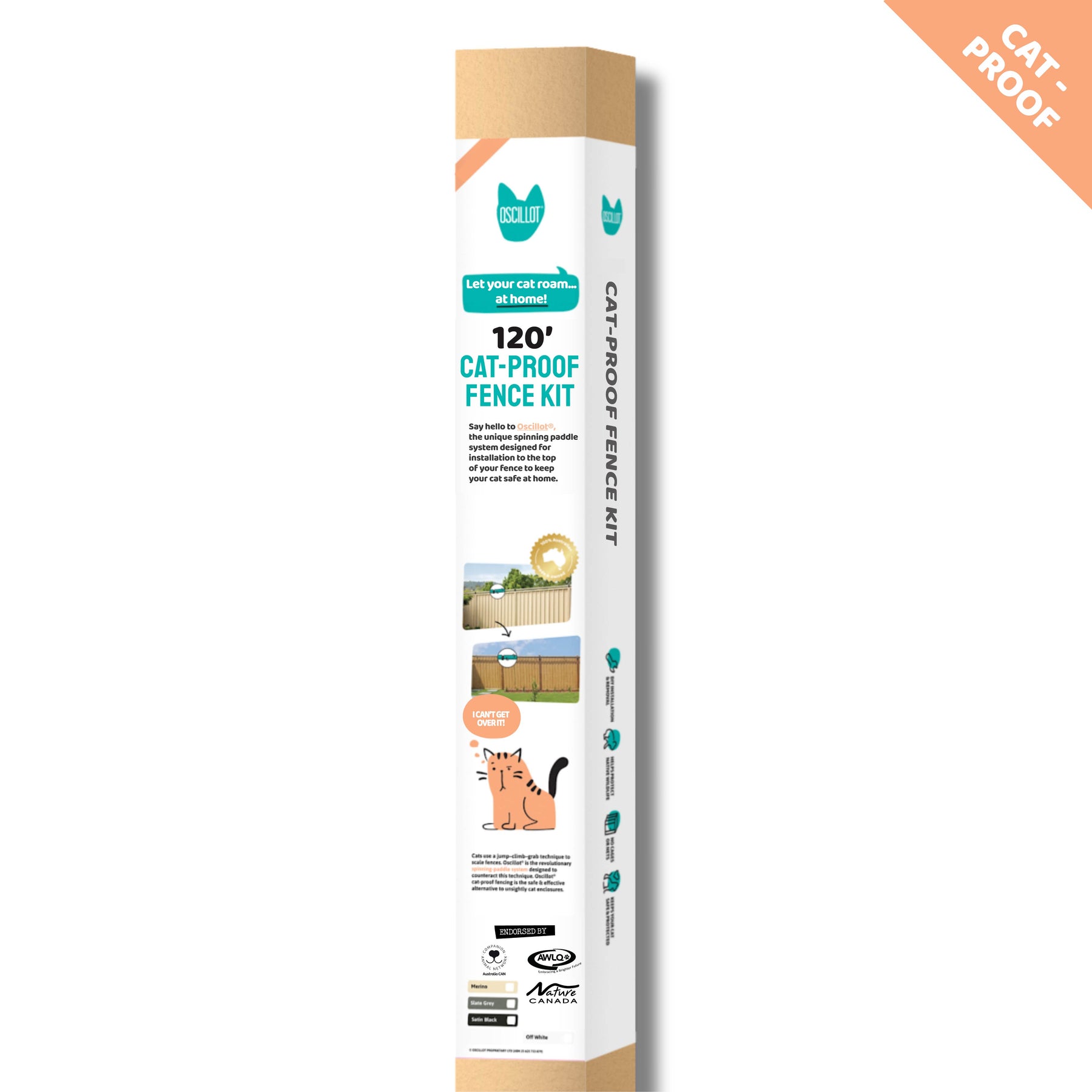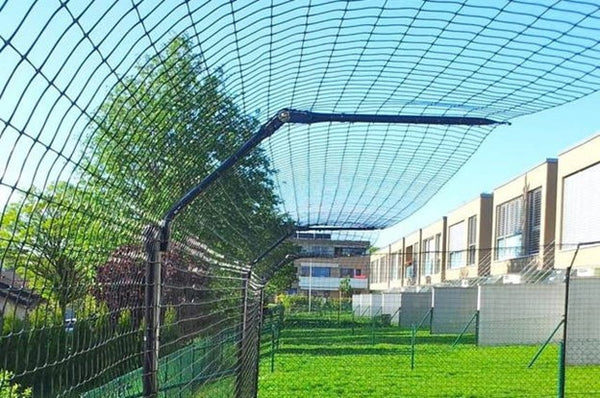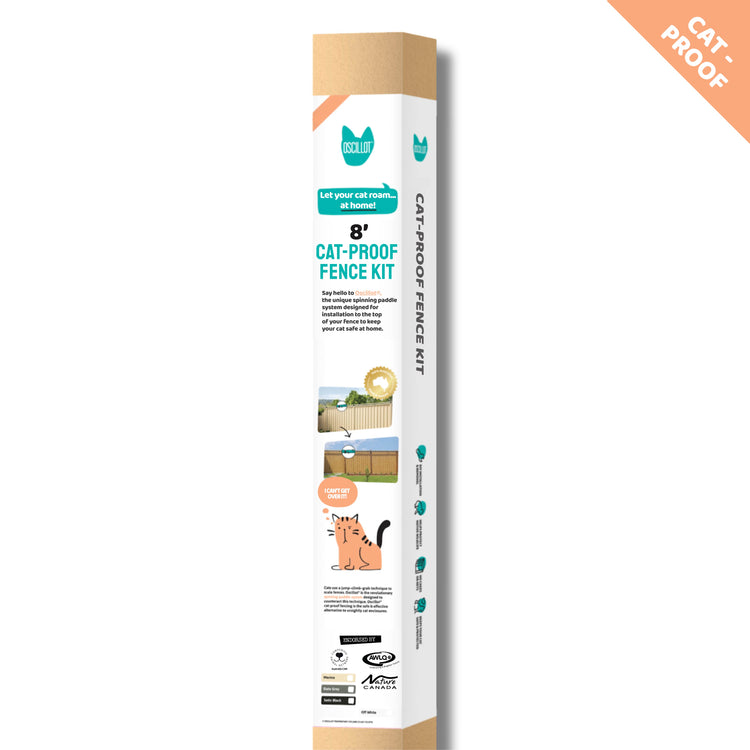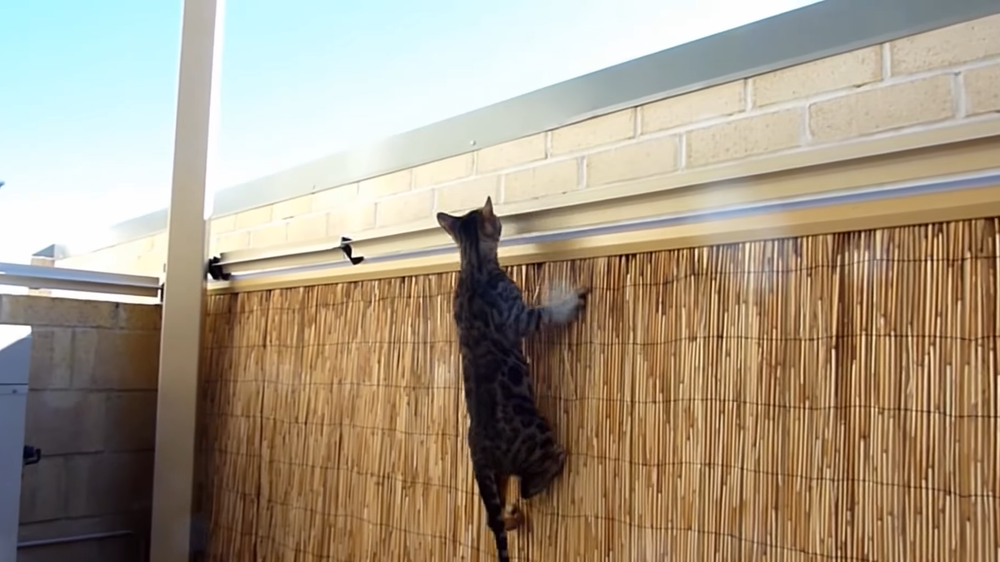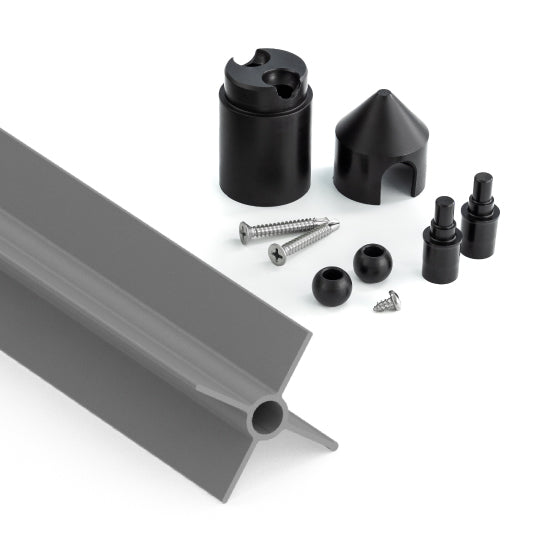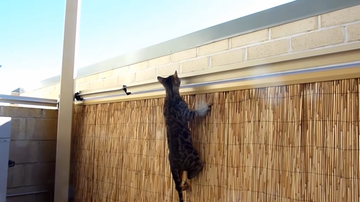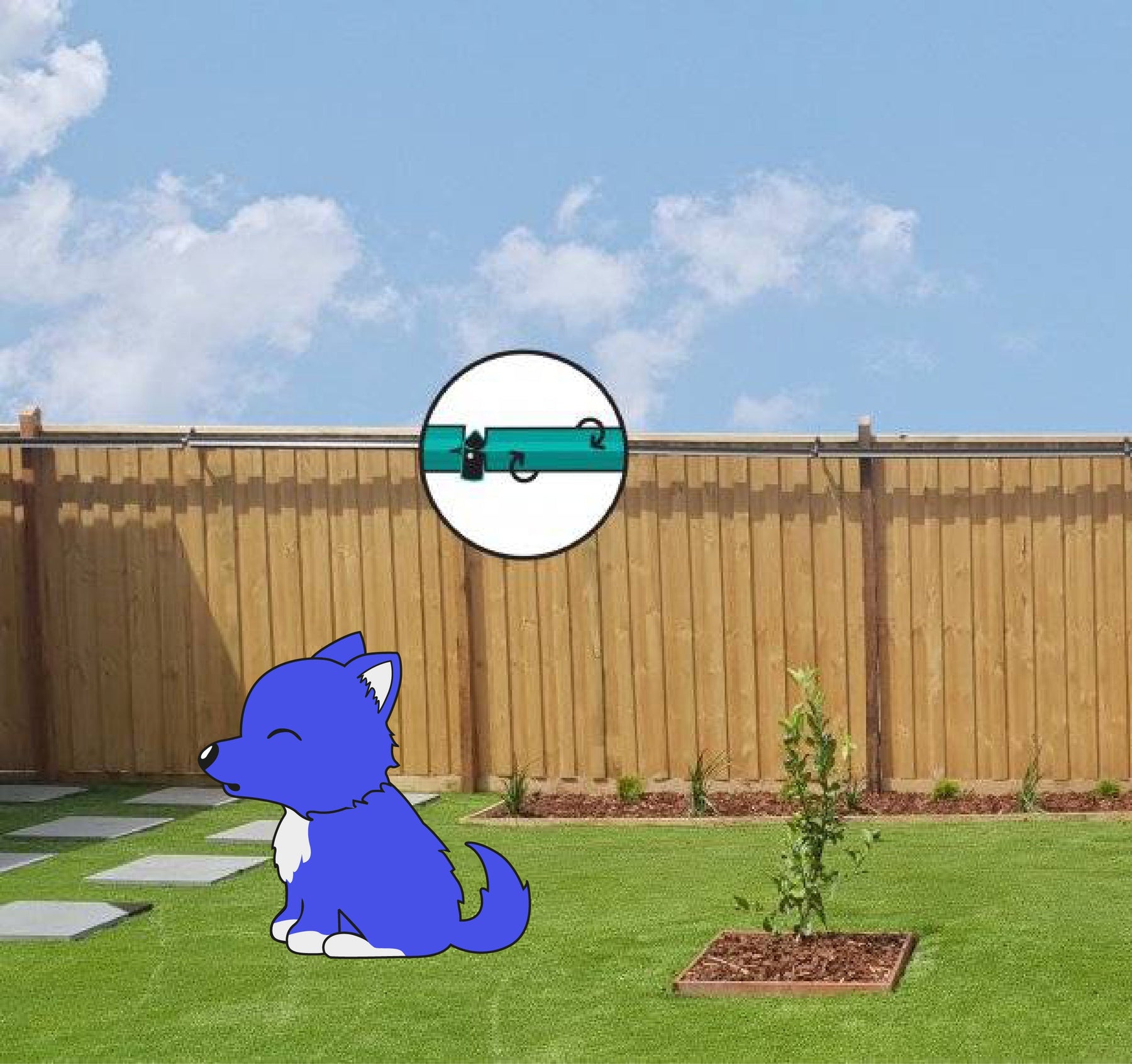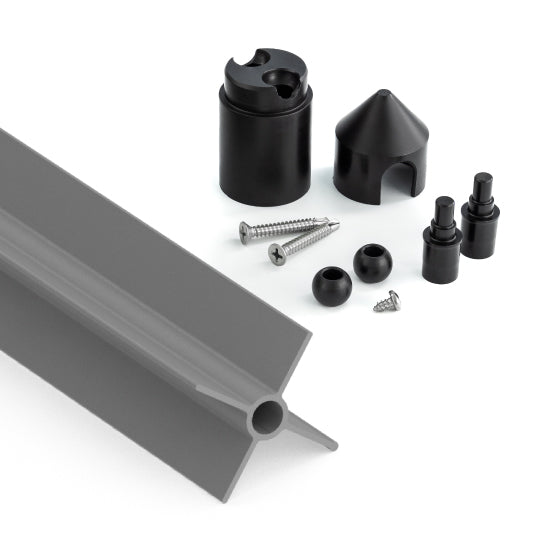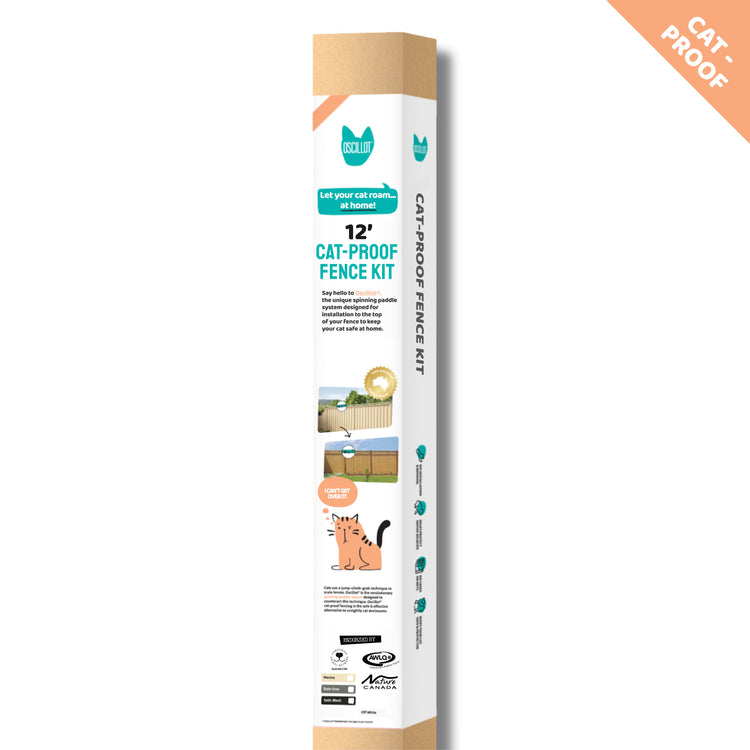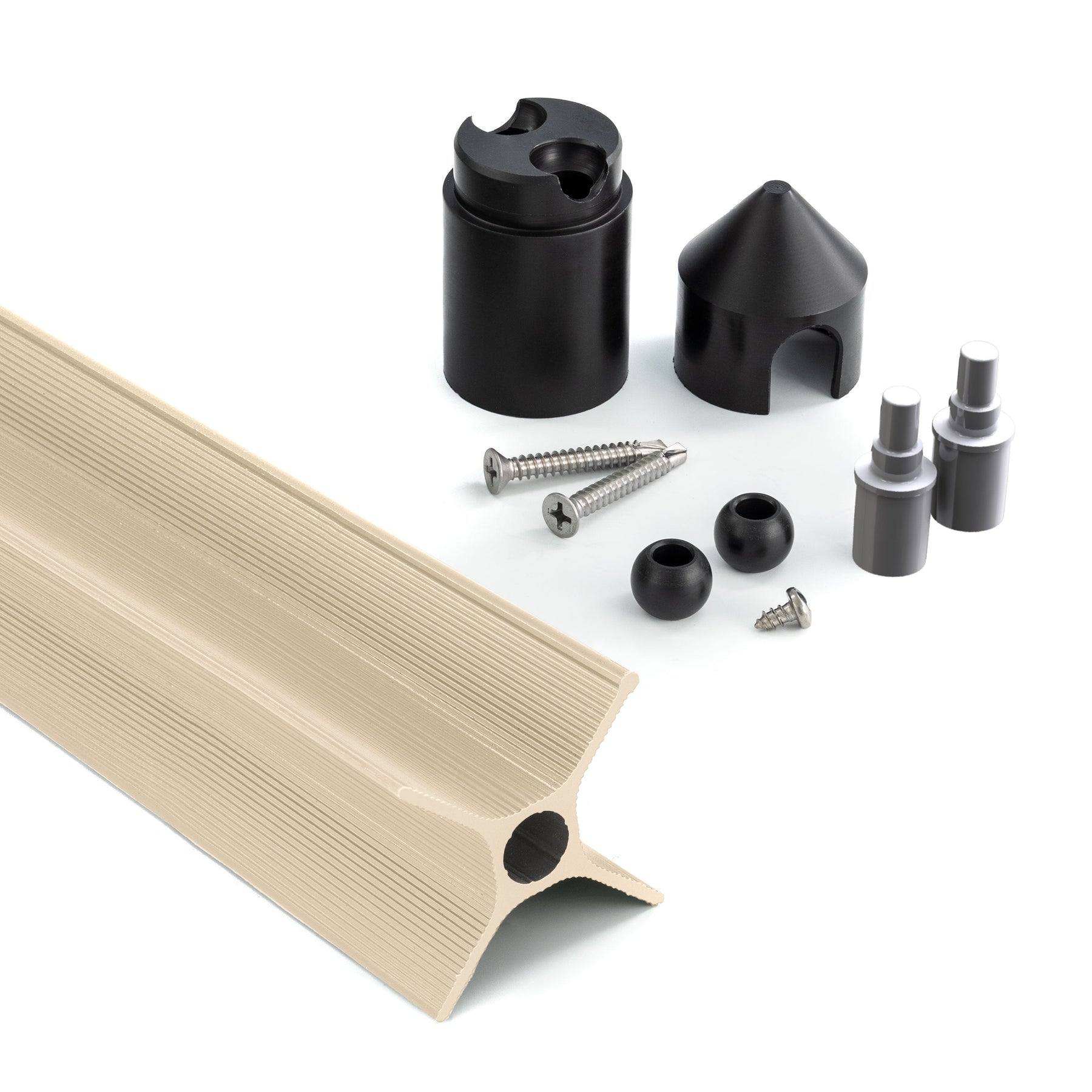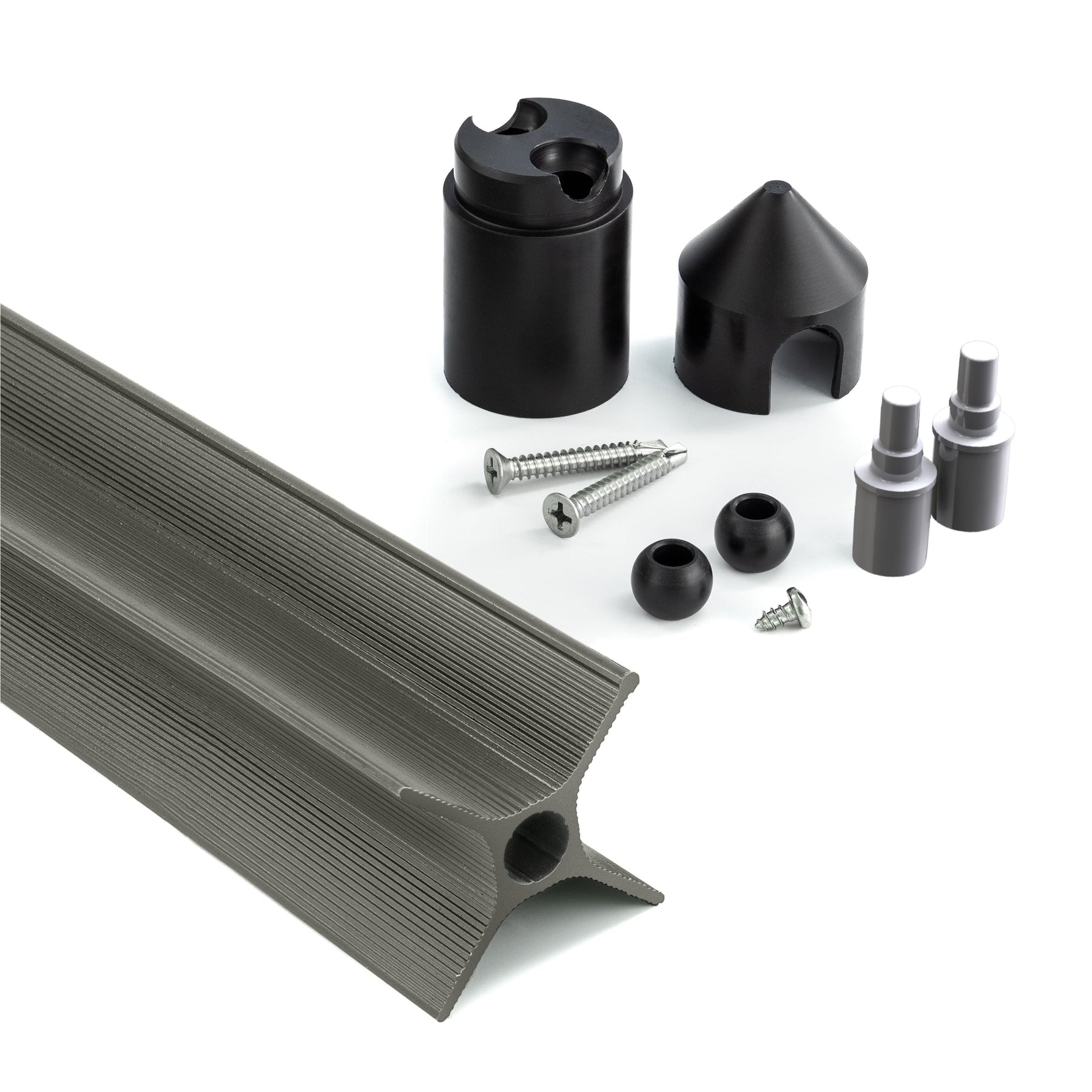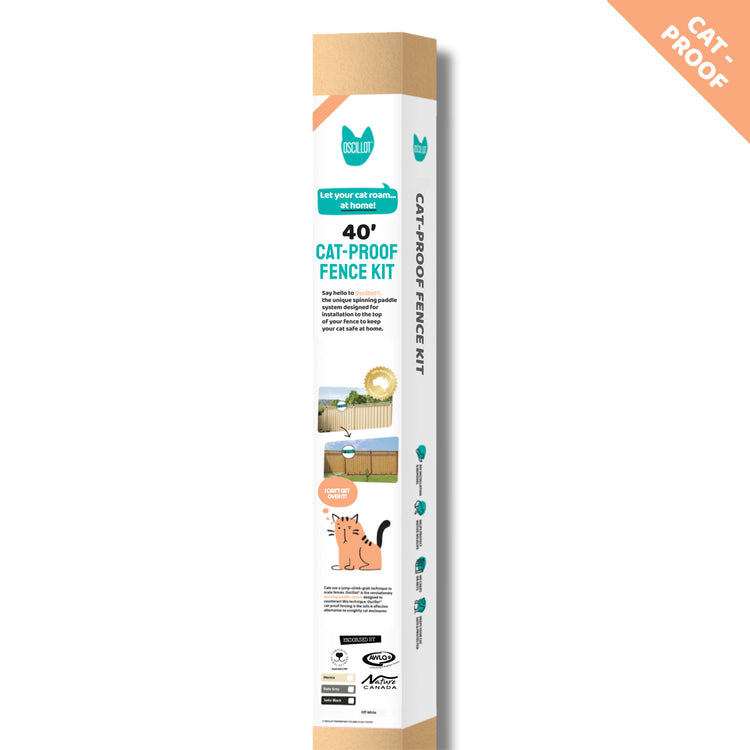Katzenzäune für arthritische und bewegungseingeschränkte Katzen: Sichere Außenbereiche schaffen

Wichtige Punkte zu Katzenzäunen für bewegungseingeschränkte Katzen
- Oscillot® katzensichere Zaunsysteme bieten sicheren Außenbereichszugang für arthritische und bewegungseingeschränkte Katzen
- DIY-Installationsoptionen sind in verschiedenen Größen von 1,2m bis 62m verfügbar
- Die empfohlene Mindestzaunhöhe beträgt 1,83 Meter für optimale Sicherheit
- Alle Systeme enthalten Paddel und doppelte Knöchel-Pfosten-Sets für die komplette Installation
- Produkte werden mit einer 60-tägigen Geld-zurück-Garantie und 3-jähriger Herstellergarantie geliefert
- Umweltmodifikationen wie sichere Zäune sind entscheidend für Katzen mit Mobilitätsproblemen
Einführung: Warum arthritische und bewegungseingeschränkte Katzen spezielle Zaunlösungen benötigen
Arthritis betrifft etwa 90% der Katzen über 12 Jahren und macht Mobilitätsprobleme zu einem häufigen Problem für Seniorkatzenbesitzer. Diese degenerative Gelenkerkrankung beeinträchtigt erheblich die Fähigkeit einer Katze, sich frei und bequem zu bewegen, und beschränkt oft ihre Möglichkeit, Outdoor-Aktivitäten zu genießen, die einst selbstverständlich waren. Für diese besonderen Katzen bietet der Zugang ins Freie sowohl erhebliche Vorteile als auch potenzielle Risiken, die sorgfältige Überlegung erfordern. Während frische Luft und natürliche Stimulation wichtig für ihre geistige Gesundheit und ihr allgemeines Wohlbefinden sind, bieten herkömmliche Zäune möglicherweise keinen ausreichenden Schutz für Katzen mit eingeschränkter Mobilität vor potenziellen Gefahren oder verhindern nicht, dass sie in gefährliche Situationen geraten.
Arthritische Katzen stehen vor einzigartigen Herausforderungen beim Erkunden im Freien. Ihre reduzierte Mobilität macht das Klettern schwierig und kann sie daran hindern, potenziellen Gefahren schnell zu entkommen, dennoch behalten viele den starken katzenhaften Wunsch, Außenbereiche zu erreichen und die sensorische Stimulation zu erleben, die die Natur bietet. Gelenkschmerzen und Steifheit können traditionelle Katzeneingrenzungsmethoden unbequem oder sogar schmerzhaft machen und erfordern spezialisierte Lösungen, die ihre körperlichen Einschränkungen berücksichtigen und dennoch angemessenen Schutz bieten. Bei Oscillot® bieten wir spezialisierte Katzeneingrenzungssysteme, die mit diesen besonderen Bedürfnissen im Hinterkopf entwickelt wurden. Unsere innovativen Zaunlösungen bieten die perfekte Balance zwischen Freiheit und Schutz für Katzen mit Arthritis oder Mobilitätsbeeinträchtigungen und ermöglichen es ihnen, sicher Outdoor-Erfahrungen zu genießen, ohne ihre Sicherheit oder ihren Komfort zu kompromittieren.
Verständnis für Mobilitätsprobleme bei Katzen
Bevor Sie eine Zaunlösung auswählen, ist es wichtig zu verstehen, wie Arthritis und Mobilitätsprobleme die Katzenbewegung beeinträchtigen. Katzen sind evolutionäre Meister darin, Schmerzen und Unbehagen zu verbergen, ein instinktives Verhalten, das aus ihrer wilden Abstammung stammt, wo das Zeigen von Schwäche sie anfällig für Raubtiere machen könnte. Diese natürliche Tendenz macht das frühe Erkennen von Mobilitätsproblemen selbst für die aufmerksamsten Tiereltern herausfordernd. Tiermedizinische Experten schätzen, dass Arthritis bei Katzen möglicherweise erheblich unterdiagnostiziert ist, genau wegen diesem Verhalten. Anzeichen für Mobilitätsprobleme umfassen:
- Widerwille zu springen oder auf zuvor zugängliche Oberflächen zu klettern
- Steifheit, besonders nach dem Ausruhen oder bei kaltem Wetter
- Veränderungen in den Pflegegewohnheiten, besonders verringerte Pflege schwer erreichbarer Bereiche
- Schwierigkeiten bei der Nutzung von Katzenklos, besonders solchen mit hohen Rändern
- Reizbarkeit, wenn bestimmte Bereiche berührt werden oder beim Handling
Für arthritische Katzen muss der Outdoor-Zugang sorgfältig verwaltet werden, um Bereicherung mit Sicherheitsaspekten auszubalancieren. Traditionelle Eingrenzungsmethoden, die sich auf die Unfähigkeit einer Katze verlassen, über hohe Strukturen zu klettern, sind möglicherweise nicht notwendig für schwer bewegungseingeschränkte Katzen, die physisch keine Zäune erklimmen können. Es ist jedoch wichtig zu bedenken, dass die Mobilität von Tag zu Tag schwanken kann, und viele arthritische Katzen behalten noch einige Kletterfähigkeiten, besonders wenn sie durch starke Stimuli wie Beute oder wahrgenommene Bedrohungen motiviert werden. Spezialisierte Lösungen, die Flucht verhindern und gleichzeitig eingeschränkte Mobilität berücksichtigen, sind wesentlich für ihre Sicherheit und ihr Wohlbefinden und bieten Tiereltern Seelenfrieden, während sie diesen besonderen Katzen ermöglichen, die geistigen und körperlichen Vorteile kontrollierten Outdoor-Zugangs zu genießen.
Wesentliche Eigenschaften von Zäunen für arthritische Katzen
Bei der Auswahl von Zäunen für Katzen mit Mobilitätsproblemen werden bestimmte Eigenschaften besonders wichtig, um sowohl Sicherheit als auch Zugänglichkeit zu gewährleisten. Das ideale Eingrenzungssystem sollte körperliche Einschränkungen berücksichtigen und dennoch wirksamen Schutz vor Flucht oder externen Bedrohungen bieten.
1. Angemessene Höhe und Design
Während Standard-Oscillot®-Systeme eine Mindestzaunhöhe von 1,83 Metern für optimale Sicherheit bei aktiven Katzen empfehlen, kann diese Höhenanforderung für Katzen mit schweren Mobilitätseinschränkungen, die nicht so hoch klettern können, angepasst werden. Die angemessene Höhe hängt weitgehend von den individuellen Fähigkeiten Ihrer Katze ab und sollte basierend auf ihrem spezifischen Grad der Mobilitätsbeeinträchtigung bewertet werden. Eine tierärztliche Beratung kann wertvolle Einblicke in die körperlichen Einschränkungen Ihrer Katze liefern und bei der Bestimmung des am besten geeigneten Eingrenzungsansatzes helfen. Der Schlüssel liegt darin, eine Balance zwischen Sicherheit und Zugänglichkeit zu schaffen, die den einzigartigen Bedürfnissen Ihrer Katze entspricht.
Unser Oscillot® 6,2 Meter katzensicheres Zaun-Set umfasst 5 Paddel und 7 Doppelknöchel-Pfosten-Sets und bietet eine sichere Barriere selbst für Katzen mit eingeschränkter Mobilität. Das innovative Paddel-System funktioniert durch das Schaffen einer physischen Barriere, die Katzen daran hindert, über den Zaun zu klettern, ohne dass sie komplexe Strukturen oder potenziell schmerzhafte Hindernisse navigieren müssen. Die rotierenden Paddel schaffen eine unpassierbare Barriere, die mit minimaler Zaunhöhe funktioniert und sie ideal für arthritische Katzen macht, die traditionelle hohe Zäune einschüchternd oder unzugänglich finden könnten. Dieses System balanciert effektiv Sicherheit mit Komfort aus und ermöglicht es bewegungseingeschränkten Katzen, Outdoor-Räume sicher zu genießen.
2. Einfache Zugangspunkte
Für arthritische Katzen sind einfache Ein- und Ausgangspunkte entscheidende Elemente eines gut gestalteten Outdoor-Bereichs. Tore sollten so gestaltet sein, dass minimales Heben für Pfoten erforderlich ist und sich reibungslos öffnen, ohne dass Katzen durch enge Räume quetschen oder herausfordernde Schwellen navigieren müssen. Niedrige Eingangspunkte mit allmählichen Übergängen zwischen Innen- und Außenräumen helfen, Gelenkbelastung zu reduzieren und die Umgebung zugänglicher zu machen. Erwägen Sie die Installation von Haustiertüren, die speziell für Senior- oder bewegungseingeschränkte Katzen entwickelt wurden und niedrigere Schwellen und breitere Öffnungen als Standardmodelle haben. Diese spezialisierten Zugangspunkte können die Lebensqualität erheblich verbessern, indem sie unabhängige Bewegung zwischen Räumen ermöglichen.
Unsere kleineren Sets, wie das 2,5 Meter katzensichere Zaun-Set (€80,00) und das 1,2 Meter katzensichere Zaun-Set (€40,00), sind perfekt für die Schaffung zugänglicher Eingangspunkte innerhalb eines größeren Eingrenzungssystems. Diese kompakten Lösungen können strategisch um Tore oder Übergangsbereiche installiert werden, um die Sicherheit zu wahren und gleichzeitig die Zugänglichkeit für Katzen mit Gelenkschmerzen oder eingeschränktem Bewegungsumfang zu maximieren. Die modulare Natur unserer Systeme ermöglicht maßgeschneiderte Konfigurationen, die die spezifischen Mobilitätsmuster und -einschränkungen Ihrer Katze berücksichtigen.
3. Rutschfeste Oberflächen
Arthritische Katzen profitieren enorm von stabilen, rutschfesten Oberflächen im gesamten Außenbereich. Rutschige Oberflächen können Stürze verursachen oder die Gelenkbelastung erhöhen, was Schmerzen potentiell verschlimmert und das Vertrauen in die Outdoor-Erkundung reduziert. Bei der Installation von Zäunen sollten Sie das Bodenmaterial innerhalb des eingezäunten Bereichs berücksichtigen, um sicherzustellen, dass es guten Halt für Katzen mit Gelenkschmerzen oder Mobilitätsproblemen bietet. Ideale Oberflächen umfassen strukturierten Beton, Kunstrasen, Gummimatten oder natürliches Gras. Vermeiden Sie glatte Materialien wie polierten Stein, glatte Fliesen oder unbedeckte Holzterrassen, die bei Nässe rutschig werden. Die strategische Platzierung rutschfester Matten oder Teppiche in Schlüsselbereichen kann sichere Wege schaffen, damit arthritische Katzen ihre Outdoor-Umgebung mit größerem Vertrauen und reduzierten Schmerzen navigieren können.
Alle unsere katzensicheren Zaun-Sets sind so konzipiert, dass sie mit bestehenden Zäunen funktionieren und es Ihnen ermöglichen, die Bodenoberflächen zu erhalten, die am besten für Ihre bewegungseingeschränkte Katze funktionieren. Diese Anpassungsfähigkeit bedeutet, dass Sie eine Outdoor-Umgebung schaffen können, die speziell auf die einzigartigen Mobilitätsbedürfnisse Ihrer Katze zugeschnitten ist, ohne Kompromisse bei Sicherheit oder ästhetischen Überlegungen einzugehen. Die Vielseitigkeit unserer Systeme berücksichtigt verschiedene Zauntypen und -materialien und macht es möglich, rutschfeste Oberflächen und zugängliche Wege im gesamten Outdoor-Bereich Ihrer Katze zu integrieren.
Die richtige Größe des Zaun-Sets für Ihren Raum wählen
Die Größe Ihres Außenbereichs bestimmt, welches Oscillot® Zaun-Set für Ihre Situation am geeignetsten ist. Wir bieten eine umfassende Auswahl von Optionen, um verschiedene Gartengröße und Konfigurationen zu berücksichtigen und sicherzustellen, dass jeder Katzenbesitzer eine Lösung finden kann, die seinen spezifischen Bedürfnissen und seinem Budget entspricht. Von kleinen Balkonen bis hin zu ausgedehnten Grundstücksgrenzen skaliert unser modulares System für praktisch jeden Raumbedarf.
Kleine Räume (Unter 5 Meter)
Für kompakte Gärten, Balkone, Terrassen oder kleine Außenbereiche bieten unsere kleineren Sets perfekte Abdeckung ohne überschüssige Materialien oder Kosten:
Oscillot® 1,2 Meter katzensicheres Zaun-Set (€40,00): Umfasst 1 Paddel und 2 Doppelknöchel-Pfosten-Sets, perfekt für die Sicherung kleiner Öffnungen oder die Schaffung eines sicheren Eingangs zu einem größeren eingezäunten Bereich. Diese kompakte Lösung ist ideal für sehr begrenzte Bereiche, in denen bewegungseingeschränkte Katzen Schutz benötigen.
Oscillot® 2,5 Meter katzensicheres Zaun-Set (€80,00): Umfasst 2 Paddel und 3 Doppelknöchel-Pfosten-Sets und bietet erweiterte Abdeckung für etwas größere Bereiche bei Beibehaltung der gleichen hochwertigen Schutzfunktion wie unsere größeren Systeme. Dieses Set bietet ausgezeichnetes Preis-Leistungs-Verhältnis für kleinere Räume.
Diese kleineren Sets sind ideal für die Schaffung sicherer Zonen innerhalb eines größeren Gartens oder für sehr kleine Außenbereiche wie Balkone oder Terrassen. Sie können auch verwendet werden, um spezifische Bereiche innerhalb eines Gartens abzugrenzen und sichere "Räume" innerhalb der größeren Outdoor-Umgebung zu schaffen, die speziell auf die Bedürfnisse Ihrer arthritischen Katze zugeschnitten sind. Die modulare Natur dieser Sets ermöglicht kreative Lösungen in begrenzten Räumen.
Mittlere Räume (5-15 Meter)
Für durchschnittlich große Gärten oder typische Wohn-Außenbereiche bietet unser mittlerer Bereich umfassende Abdeckung mit flexiblen Installationsoptionen:
Oscillot® 5 Meter katzensicheres Zaun-Set (€140,00): Umfasst 4 Paddel und 5 Doppelknöchel-Pfosten-Sets und bietet erhebliche Abdeckung für mittelgroße Bereiche. Dieses beliebte Set balanciert umfassenden Schutz mit Erschwinglichkeit für typische Gartenbereiche aus.
Oscillot® 6,2 Meter katzensicheres Zaun-Set (€152,00): Umfasst 5 Paddel und 7 Doppelknöchel-Pfosten-Sets und bietet erweiterte Abdeckung mit zusätzlichen Stützpfosten für verbesserte Stabilität. Die zusätzlichen Pfosten machen dieses Set besonders geeignet für Bereiche mit unebenem Gelände oder bestehenden Zäunen, die möglicherweise zusätzliche Verstärkung benötigen.
Oscillot® 12,4 Meter katzensicheres Zaun-Set (€360,00): Umfasst 10 Paddel und 13 Doppelknöchel-Pfosten-Sets und bietet umfangreiche Abdeckung für größere mittelgroße Räume. Diese umfassende Lösung kann einen erheblichen Teil eines typischen Wohngartens mit einem einzigen Set sichern.
Diese mittelgroßen Sets bieten ausgezeichnete Abdeckung für typische Gartenbereiche und schaffen eine sichere Outdoor-Umgebung für arthritische Katzen zum Genießen ohne Fluchtrisiko. Die Flexibilität dieser Systeme ermöglicht Anpassungen um bestehende Landschaftsmerkmale, Gartenbeete oder Strukturen herum und stellt sicher, dass die Outdoor-Erfahrung Ihrer Katze sowohl sicher als auch anregend bleibt.
Große Räume (15+ Meter)
Für größere Grundstücke, ausgedehnte Gärten oder kompletten Perimeterschutz bieten unsere umfangreichen Sets umfassende Abdeckung mit maximaler Sicherheit:
Oscillot® 18,6 Meter katzensicheres Zaun-Set (€424,00): Perfekt für mittlere bis große Gärten, diese umfassende Lösung umfasst genügend Komponenten, um erhebliche Außenbereiche zu sichern. Das Set bietet umfangreiche Abdeckung für Grundstücke mit größeren Perimetern bei Beibehaltung der gleichen hochwertigen Schutzfunktion wie unsere kleineren Systeme.
Oscillot® 24,8 Meter katzensicheres Zaun-Set (€680,00): Ideal für größere Grundstücksgrenzen, dieses umfangreiche Set bietet kompletten Schutz für erhebliche Außenbereiche. Das System umfasst ausreichende Komponenten, um die meisten Wohngrundstückperimeter mit einer einzigen Set-Installation zu sichern.
Oscillot® 37,2 Meter katzensicheres Zaun-Set (€816,00): Umfassende Abdeckung für ausgedehnte Bereiche, diese professionelle Lösung bietet komplette Sicherheit für große Grundstücke oder komplexe Perimeterdesigns. Die umfangreiche Komponentenanzahl ermöglicht Flexibilität bei der Installation um herausfordernde Landschaftsmerkmale oder Grundstücksgrenzen herum.
Oscillot® 62 Meter katzensicheres Zaun-Set (€1.295,00): Unsere umfangreichste Option für kompletten Grundstücksschutz, diese Premium-Lösung bietet maximale Abdeckung für große Anwesen oder Grundstücke mit ausgedehnten Grenzen. Das umfassende Set umfasst alles Notwendige, um selbst die erheblichsten Außenbereiche zu sichern.
Diese größeren Sets stellen sicher, dass selbst Katzen mit eingeschränkter Mobilität erhebliche Außenbereiche sicher eingeschlossen innerhalb Ihrer Grundstücksgrenzen genießen können. Die umfangreiche Abdeckung ermöglicht die Schaffung verschiedener Umweltzonen innerhalb des gesicherten Bereichs und bietet abwechslungsreiche Stimulation und Erfahrungen für bewegungseingeschränkte Katzen bei vollständiger Sicherheit im gesamten Perimeter.
Installationsüberlegungen für bewegungseingeschränkte Katzen
Bei der Installation von Zäunen für arthritische oder bewegungseingeschränkte Katzen können mehrere besondere Überlegungen den Raum zugänglicher und komfortabler machen und ihre Outdoor-Erfahrung verbessern, während sie ihre körperlichen Einschränkungen berücksichtigen. Durchdachte Designentscheidungen können erheblich beeinflussen, wie erfolgreich Ihre Katze ihre gesicherte Outdoor-Umgebung nutzen und genießen wird.
Zugängliche Wege schaffen
Etablieren Sie klare, ebene Wege innerhalb des eingezäunten Bereichs, die es Katzen mit Mobilitätsproblemen ermöglichen, einfach zu navigieren, ohne zusätzliche Gelenkbelastung oder Unbehagen zu verursachen. Diese Wege sollten Schlüsselbereiche des Interesses wie Ruheplätze, geschützte Bereiche und Zugangspunkte zum Haus verbinden. Vermeiden Sie steile Neigungen oder unebene Oberflächen, die Unbehagen verursachen oder das Sturzrisiko für Katzen mit beeinträchtigter Mobilität erhöhen könnten. Erwägen Sie die Verwendung von Materialien wie glatten Pflastersteinen, verdichtetem Kies mit stabiler Oberfläche oder ebenen Holzwegen mit rutschfesten Behandlungen, um diese zugänglichen Routen zu schaffen. Gut gestaltete Wege verbessern nicht nur die physische Zugänglichkeit, sondern fördern auch die Erkundung durch die Schaffung eines Sicherheitsgefühls für Katzen, die andernfalls zögern könnten, sich in Bereiche mit herausforderndem Gelände zu wagen.
Alle unsere Zaun-Sets können installiert werden, um mit Ihrem bestehenden Gartenlayout zu funktionieren, was es Ihnen ermöglicht, zugängliche Wege für Ihre bewegungseingeschränkte Katze zu erhalten. Die Flexibilität unserer Systeme bedeutet, dass Sie den eingezäunten Bereich um die spezifischen Bedürfnisse und Bewegungsmuster Ihrer Katze herum gestalten können, anstatt sie zu zwingen, sich an eine standardisierte Eingrenzungslösung anzupassen. Dieses Anpassungspotential ist besonders wertvoll für Katzen mit Arthritis oder Mobilitätsbeeinträchtigungen, da ihre Fähigkeit, verschiedene Geländetypen zu navigieren, im Vergleich zu jüngeren, beweglicheren Katzen erheblich beeinträchtigt sein kann.
Strategische Ruhebereiche
Integrieren Sie komfortable Ruheplätze im gesamten eingezäunten Bereich, um dem erhöhten Ruhebedürfnis gerecht zu werden, das viele arthritische Katzen erfahren. Diese Ruhestationen sollten an verschiedenen Punkten entlang zugänglicher Wege positioniert werden, so dass Katzen während der Erkundung Pausen einlegen können, ohne weit zwischen komfortablen Plätzen reisen zu müssen. Arthritische Katzen profitieren davon, mehrere Plätze zum Ausruhen und Beobachten ihrer Umgebung zu haben, idealerweise auf verschiedenen Höhen, um unterschiedliche Komfortniveaus und Vorlieben zu berücksichtigen. Erwägen Sie sowohl bodennahe Optionen als auch leicht erhöhte Plattformen, die über sanfte Rampen oder niedrige Stufen zugänglich sind. Wetterbeständige Kissen, beheizte Outdoor-Betten (für kühlere Klimazonen) und geschützte Ruhennischen können alle den Komfort für Katzen mit Gelenkschmerzen oder Mobilitätseinschränkungen verbessern.
Schutz und Schatten
Stellen Sie sicher, dass der eingezäunte Bereich angemessenen Schutz vor den Elementen umfasst, da arthritische Katzen besonders empfindlich auf Temperaturveränderungen und Umweltbedingungen reagieren. Die Exposition gegenüber kaltem, feuchtem Wetter kann Gelenkschmerzen und Steifheit erheblich verschlimmern, während Überhitzung für Seniorkatzen mit reduzierter thermoregulatorischer Kapazität gefährlich sein kann. Bieten Sie mehrere geschützte Bereiche im gesamten Raum, die Schutz vor Regen, Wind und direkter Sonneneinstrahlung bieten. Diese Schutzräume sollten über die ebenen Wege leicht zugänglich sein und strategisch positioniert werden, um Optionen in verschiedenen Bereichen des eingezäunten Raums zu bieten. Erwägen Sie sowohl natürlich beschattete Bereiche unter Bäumen oder Sträuchern als auch zweckgebaute Schutzräume wie kleine Katzenhäuser oder überdachte Plattformen. Für Katzen in kälteren Klimazonen können beheizte Outdoor-Schutzräume die Outdoor-Zeit während kühlerer Jahreszeiten komfortabler machen und den Zeitraum verlängern, in dem Ihre bewegungseingeschränkte Katze sicher Outdoor-Zugang genießen kann.
DIY-Installationstipps für Tiereltern
Alle Oscillot® katzensicheren Zaun-Sets sind für unkomplizierte DIY-Installation konzipiert und machen sie für die meisten Tiereltern zugänglich, unabhängig von technischer Expertise oder vorheriger Erfahrung mit Heimwerkerprojekten. Unsere umfassenden Anleitungen führen Sie durch jeden Schritt des Prozesses, während das modulare Design Anpassungen an Ihre spezifische Grundstückskonfiguration und die einzigartigen Bedürfnisse Ihrer Katze ermöglicht. Hier sind einige spezifische Tipps für die Installation von Zäunen mit arthritischen Katzen im Hinterkopf:
Schritt 1: Bewerten Sie die Mobilität Ihrer Katze
Bevor Sie installieren, beobachten Sie sorgfältig die Bewegungsmuster Ihrer Katze, um ihre spezifischen Einschränkungen und Fähigkeiten zu verstehen. Diese detaillierte Bewertung sollte das Beobachten beinhalten, wie sie verschiedene Oberflächen navigieren, ihre Fähigkeit zu springen oder zu klettern, und alle Bereiche, in denen sie Unbehagen oder Zögern zu zeigen scheinen. Notieren Sie ihre bevorzugten Ruheplätze, typischen Aktivitätsmuster während des Tages und Umweltfaktoren, die ihre Mobilität zu beeinflussen scheinen. Diese gründliche Beobachtungsperiode wird Ihnen helfen, den eingezäunten Raum an ihre Bedürfnisse anzupassen und potenzielle Problembereiche zu identifizieren, bevor sie auftreten. Erwägen Sie, eine Woche vor der Installation ein Mobilitätstagebuch zu führen, um Muster zu dokumentieren, die Sie sonst übersehen könnten, wie zum Beispiel, wie Wetterveränderungen die Gelenksteifheit beeinflussen oder welche Outdoor-Oberflächen Ihre Katze vermeidet oder bevorzugt.
Schritt 2: Planen Sie Ihr Layout
Kartieren Sie den Installationsbereich mit besonderer Aufmerksamkeit auf die Schaffung zugänglicher Zonen, die die spezifischen Mobilitätsprobleme Ihrer Katze berücksichtigen. Eine detaillierte Planungsphase kann kostspielige Modifikationen später verhindern und sicherstellen, dass der Raum von Tag eins an den Bedürfnissen Ihrer Katze entspricht. Berücksichtigen Sie:
- Ebene Bodenbereiche für einfaches Gehen ohne Gelenkbelastung oder Gleichgewichtsprobleme
- Beschattete Plätze für Temperaturregulierung bei heißem Wetter
- Nähe zu Hauszugangspunkten, um die Reiseentfernung für Katzen mit begrenzter Ausdauer zu minimieren
- Schutz vor Nachbarschaftshunden oder anderen potenziellen Stressoren, die Ihre Katze dazu bringen könnten, trotz Mobilitätseinschränkungen einen Fluchtversuch zu unternehmen
Schritt 3: Installationsprozess
Unsere Oscillot® Zaun-Sets kommen mit umfassenden Installationsanleitungen, die Sie durch jede Phase des Setup-Prozesses führen. Das unkomplizierte Design erfordert nur grundlegende Werkzeuge und moderate DIY-Fähigkeiten und macht es für die meisten Tiereltern zugänglich. Der grundlegende Prozess umfasst:
- Befestigung der Doppelknöchel-Pfosten-Sets an Ihrem bestehenden Zaun in den empfohlenen Abständen, wobei sichergestellt wird, dass sie eben und sicher befestigt sind
- Sicherung der Paddel an den Pfosten mit der mitgelieferten Hardware, wobei überprüft wird, dass sie sich frei drehen und eine kontinuierliche Barriere schaffen
- Sicherstellen, dass alle Komponenten fest befestigt und richtig ausgerichtet sind, um Lücken oder Schwachstellen im Eingrenzungssystem zu verhindern
Für arthritische Katzen stellen Sie sicher, dass alle Tore oder Zugangspunkte besonders einfach zu navigieren sind, mit minimalen Höhenunterschieden oder Hindernissen. Erwägen Sie die Installation zusätzlicher Unterstützung oder maßgeschneiderter Eingangspunkte, wenn Ihre bestehenden Zugangsbereiche Herausforderungen für Ihre bewegungseingeschränkte Katze darstellen. Die modulare Natur unserer Systeme ermöglicht kreative Lösungen zur Bewältigung spezifischer Mobilitätsprobleme bei gleichzeitiger Aufrechterhaltung der Sicherheit des gesamten Eingrenzungssystems.
Besondere Überlegungen für Mehrkatzenhaushalte
In Haushalten mit sowohl bewegungseingeschränkten als auch vollmobilen Katzen sind besondere Überlegungen notwendig, um die Bedürfnisse aller Katzenfamilienmitglieder zu erfüllen und gleichzeitig die Sicherheit und den Komfort aller zu gewährleisten. Der ideale Außenbereich sollte verschiedene Mobilitätsniveaus berücksichtigen, ohne die Sicherheit für irgendein Haushaltsmitglied zu kompromittieren, was durchdachtes Design und potenzielle Anpassung standardisierter Eingrenzungsansätze erfordert.
Zonenbereiche
Erwägen Sie die Schaffung verschiedener Zonen innerhalb Ihres eingezäunten Außenbereichs, um den unterschiedlichen Bedürfnissen und Fähigkeiten verschiedener Katzen in Ihrem Haushalt gerecht zu werden. Dieser strategische Ansatz ermöglicht es jeder Katze, Outdoor-Zugang auf eine Weise zu genießen, die ihren individuellen körperlichen Fähigkeiten und Vorlieben entspricht. Gut gestaltete Zonierung könnte umfassen:
- Niedrigaktivitätszonen mit komfortablen Ruheplätzen, sanfter sensorischer Stimulation und ebenen Oberflächen für arthritische Katzen, die ruhige Beobachtung und begrenzte Bewegung bevorzugen
- Anregendere Bereiche mit Klettermöglichkeiten, interaktiven Features und abwechslungsreichem Gelände für mobilere Katzen, die körperliche Herausforderungen und Bereicherung benötigen
Unsere größeren Sets, wie das 37,2 Meter katzensichere Zaun-Set (€816,00) oder das 62 Meter katzensichere Zaun-Set (€1.295,00), bieten ausreichend Platz, um diese differenzierten Zonen innerhalb eines einzigen gesicherten Perimeters zu schaffen. Die umfangreiche Abdeckung ermöglicht kreative Raumaufteilung bei gleichzeitiger Aufrechterhaltung konsistenter Sicherheit im gesamten Bereich. Diese größeren Systeme können komplexe Layouts mit mehreren Aktivitätszonen aufnehmen, die auf die Bedürfnisse verschiedener Katzen zugeschnitten sind.
Fluchtprävention für alle Mobilitätsniveaus
Während Ihre arthritische Katze aufgrund körperlicher Einschränkungen möglicherweise nicht hoch springen oder klettern kann, könnten andere Katzen im Haushalt volle Mobilität behalten und robustere Eingrenzungsmaßnahmen erfordern. Bei der Gestaltung Ihres Außenbereichs ist es wesentlich sicherzustellen, dass Ihre Zaunlösung die Fähigkeiten Ihrer beweglichsten Katze berücksichtigt und gleichzeitig für diejenigen mit Mobilitätsproblemen zugänglich bleibt. Dieser ausgewogene Ansatz könnte die Kombination verschiedener Eingrenzungsstrategien innerhalb eines einzigen Systems oder die Implementierung zusätzlicher Sicherheitsfeatures in spezifischen Bereichen erfordern.
Saisonale Anpassungen für arthritische Katzen
Katzen mit Arthritis erfahren oft Schwankungen in ihrer Mobilität basierend auf Wetterbedingungen und saisonalen Veränderungen. Kaltes oder feuchtes Wetter verschlimmert typischerweise Gelenkschmerzen und Steifheit, während wärmere, trockene Bedingungen vorübergehende Linderung von Symptomen bieten können. Das Verständnis dieser Muster ermöglicht es Ihnen, saisonale Anpassungen an Ihrem Außenbereich vorzunehmen, die Komfort und Zugänglichkeit das ganze Jahr über maximieren und sicherstellen, dass Ihre Katze unabhängig von sich ändernden Umweltbedingungen Outdoor-Zugang genießen kann.
Winterüberlegungen
Während kälterer Monate stehen arthritische Katzen vor zusätzlichen Herausforderungen, die durchdachte Modifikationen ihrer Outdoor-Umgebung erfordern. Gelenkschmerzen intensivieren sich typischerweise bei kaltem Wetter, reduzieren die Mobilität und erhöhen potentiell das Unbehagen während der Outdoor-Erkundung. Um diesen saisonalen Veränderungen gerecht zu werden, erwägen Sie die Implementierung dieser spezialisierten Winteranpassungen:
- Hinzufügung von Windschutz innerhalb des eingezäunten Bereichs, um die Exposition gegenüber kalten Zugluft zu reduzieren, die Gelenkschmerzen verschlimmern und die Outdoor-Zeit unbequem machen kann
- Bereitstellung beheizter Outdoor-Schutzräume mit niedrigen Eingängen, die warme Rückzugsorte bieten, ohne schwieriges Klettern oder Springen zu erfordern
- Installation wetterbeständiger Heizpads an Schlüssel-Ruheplätzen, um Gelenksteifheit während des Outdoor-Entspannens zu reduzieren
- Begrenzung der Outdoor-Zeit während besonders kalter oder feuchter Tage, wenn Symptome wahrscheinlich am schwersten sind
Sommeranpassungen
Während wärmerer Monate entstehen verschiedene Herausforderungen für arthritische Katzen, die spezifische Umweltmodifikationen erfordern. Während Gelenkschmerzen bei warmem Wetter abnehmen können, steigt das Risiko der Überhitzung, besonders für Seniorkatzen, die oft eine reduzierte thermoregulatorische Kapazität haben. Um eine komfortable Sommerumgebung innerhalb Ihres eingezäunten Außenbereichs zu schaffen, erwägen Sie diese spezialisierten Anpassungen:
- Sicherstellen angemessenen Schattens den ganzen Tag durch Einbeziehung sowohl natürlichen Schattens von Bäumen oder Sträuchern als auch künstlicher Schattenstrukturen wie Vordächer oder Pergolen
- Bereitstellung mehrerer frischer Wasserquellen im gesamten eingezäunten Bereich zur Förderung der Hydration und Verhinderung von Dehydration bei heißem Wetter
- Schaffung kühler Ruhebereiche mit guter Luftzirkulation unter Verwendung erhöhter Plattformen, Kühlmatten oder natürlich kühler Oberflächen wie Stein in beschatteten Lagen
- Erwägung der Installation von Verneblern oder flachen Wasserspielen, die Kühlmöglichkeiten bieten, ohne schwierigen Zugang zu erfordern
Überwachung und Wartung
Sobald Ihr Oscillot® katzensicherer Zaun installiert ist, sind regelmäßige Überwachung und Wartung wesentlich, um kontinuierliche Sicherheit und Funktionalität für Ihre bewegungseingeschränkte Katze zu gewährleisten. Ein proaktiver Ansatz zur Systempflege verlängert nicht nur die Lebensdauer Ihrer Investition, sondern verhindert auch potenzielle Sicherheitskompromisse, die Ihre verwundbare Katze in Gefahr bringen könnten.
Regelmäßige Inspektionen
Überprüfen Sie Ihr Zaunsystem regelmäßig auf Probleme, die seine Effektivität oder Sicherheit kompromittieren könnten. Die Etablierung einer konsistenten Inspektionsroutine hilft, potenzielle Probleme zu identifizieren, bevor sie zu ernsthaften Anliegen werden. Während dieser Inspektionen achten Sie besonders auf:
- Sichere Befestigung aller Komponenten, Überprüfung auf Lockerung von Schrauben oder Montagehardware, die die Systemstabilität beeinträchtigen könnte
- Ordnungsgemäße Ausrichtung der Paddel, um sicherzustellen, dass sie sich frei drehen und eine effektive Barriere ohne Lücken oder Hindernisse schaffen
- Jegliche Schäden durch Wetterereignisse, fallende Äste oder andere Umweltfaktoren, die die Systemintegrität beeinträchtigen könnten
- Potenzielle Schwachstellen oder Bereiche, die möglicherweise Verstärkung benötigen, besonders um Tore oder Zugangspunkte herum
Beobachtung des Verhaltens Ihrer Katze
Überwachen Sie, wie Ihre arthritische Katze mit dem eingezäunten Bereich interagiert, um sicherzustellen, dass er weiterhin ihre sich ändernden Bedürfnisse erfüllt, während sich ihr Zustand entwickelt. Katzen mit progressiven Erkrankungen wie Arthritis können im Laufe der Zeit Veränderungen in ihrer Mobilität erfahren, die periodische Anpassungen ihrer Umgebung erfordern. Achten Sie auf diese Verhaltensindikatoren:
- Können sie bequem durch den ganzen Raum navigieren, oder zeigen sie Anzeichen von Schwierigkeiten mit bestimmten Bereichen oder Features?
- Zeigen sie Anzeichen verstärkter Schmerzen nach der Outdoor-Zeit, wie Widerwille sich zu bewegen, übermäßige Pflege spezifischer Gelenke oder Veränderungen im Temperament?
- Gibt es Bereiche, die sie vermeiden oder zu bevorzugen scheinen, was potenzielle Komfortprobleme oder Umweltvorlieben andeutet?
Verwenden Sie diese Beobachtungen, um bei Bedarf Anpassungen an der Umgebung vorzunehmen und den Raum anzupassen, um den sich ändernden Mobilitätsmustern und Vorlieben Ihrer Katze gerecht zu werden. Diese laufende Bewertung stellt sicher, dass Ihr Außenbereich zugänglich und angenehm bleibt, selbst wenn sich der Zustand Ihrer Katze verschlechtert oder schwankt.
Kombination von Zäunen mit anderen Mobilitätshilfen
Für Katzen mit erheblichen Mobilitätsproblemen reicht Zäunung allein möglicherweise nicht aus, um eine wirklich zugängliche Outdoor-Umgebung zu schaffen. Ein umfassender Ansatz beinhaltet oft die Ergänzung Ihres Oscillot® Zaunsystems mit anderen spezialisierten Mobilitätshilfen, die spezifische Einschränkungen ansprechen. Diese ergänzenden Lösungen arbeiten zusammen, um eine ganzheitliche Outdoor-Erfahrung zu schaffen, die auf die einzigartigen Bedürfnisse Ihrer Katze zugeschnitten ist.
Sanfte Rampen und Stufen
Installieren Sie Rampen mit geringer Neigung oder flache Stufen, um Katzen bei der Navigation kleiner Höhenänderungen innerhalb des eingezäunten Bereichs zu helfen. Diese Zugänglichkeitsfeatures sollten speziell für arthritische Katzen entwickelt werden, mit mehreren Schlüsselmerkmalen:
- Sanfte Neigungen mit nicht mehr als 20 Grad Neigung, um Gelenkbelastung während des Auf- oder Abstiegs zu minimieren
- Rutschfeste Oberflächen, die sicheren Halt auch bei feuchten Bedingungen bieten
- Angemessene Breite (mindestens 30cm), um Katzen aufzunehmen, die möglicherweise einen veränderten Gang oder Gleichgewichtsprobleme haben
- Seitenschienen oder Begrenzungen, die versehentliche Stürze für Katzen mit beeinträchtigtem Gleichgewicht verhindern





